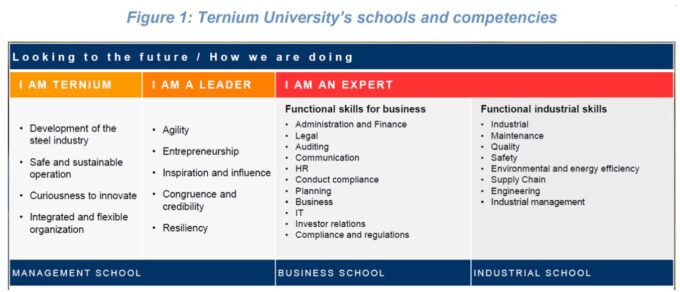
The four drivers of sustainable happiness at work
In the face of burnout, quiet quitting, and workplace complexity, happiness is one often overlooked factor that can transform leadership resilience and team performance....
Audio available

by Omar Toulan, Rodrigo Piña Published November 14, 2023 in Human Resources • 5 min read
Ternium is Latin America’s leading steel maker, covering the value chain from iron-ore mining to manufacturing high-end products. Among its 18 current production units around the region, those in Mexico, Argentina, and Brazil lead the way.
In 2018, in response to two significant challenges, the organization instituted major HR-led changes. The first was a substantial re-organization of the business. In 2017, Ternium had purchased Brazilian steel producer Companhia Siderúrgica do Atlântico Sul(CSA). Prior to that date, the firm’s separate production units had, for some time, operated in silos. From the time of the CSA purchase, however, the company opted for a centralization strategy for certain key activities, including finance, health and safety, and a newly created industrial coordination function, in order to inculcate an organization-wide management style and culture. HR was to be one of the centralized departments. What was not run from headquarters would be coordinated at the center with production units.
In line with the new corporate strategy, various HR activities were consolidated, including talent planning, acquisition, and – as discussed below – development. To meet Ternium’s growing talent requirements, the HR function sought to foster a learning mentality and an agility in both its offerings for employees and its own activities.
Meanwhile, the war for talent was heating up in Latin America. Digitalization of various sectors, notably IT and banking, was drawing new entrants away from traditional manufacturing
In order to become more appealing to potential hires, the company conducted a comprehensive study of how its employee value proposition (EVP) was perceived by its 3,000 current and former employees, target-market candidates, and rejected applicants. According to respondents, Ternium’s leading positive attribute as an employer was its encouragement of continual professional development; however, its provision of learning opportunities only came in at fifth on the list. This information underscored the need for the EVP to align with employees’ experiences; candidates wanted, and expected, to be able to learn at the company.
Even before 2018, the business had built up a long tradition of investment in extensive training programs, including for top business and technical prospects. However, these programs were untailored, with every employee receiving the same program, which trainers delivered in the same way. In 2018 the organization decided to take a new approach to talent development.

Crucial to these changes was the establishment in 2019 of Ternium University (TU). Intended to function as a centralized purveyor of learning, it provided both online and in-person offerings in various formats and languages, accommodating every employee preference. TU was divided into three academies with distinct programs: Business, Management, and Technical. Offerings were also organized to encourage three broad competencies across the company: understanding of corporate culture (“I am Ternium”); leadership skills (“I am a Leader”); and functional capabilities (“I am an Expert”) [See Figure 1]. the modules were integrated into the company’s new, consolidated top-level Leadership Training Roadmap. This program was designed to create a cadre of leaders from across the company who had benefited from an aligned learning journey.
The university has been the linchpin of Ternium’s educational escalation from an old-fashioned function-based lecture model to supported, self-directed learning based on individual initiative and personal choice. To start shaping their personal development, individual employees meet with their managers to identify gaps in their skillsets and to tailor a training program to fill them. They could also chart a path towards a specific position in the company. For those looking at learning from a career-long perspective, the company is clear about what it can offer those employees willing to commit to self-improvement.
All TU courses are available to every Ternium employee – salaried or on short-term contracts – regardless of seniority level, geographic location, or specialty, and employees learn at their own pace. The courses are shaped from the learner’s perspective, with the aim of providing what they feel would benefit them most. The learner help inform decisions on the theme and duration of the courses, the provision of content in Spanish, Portuguese, and English, as well as the mix of online, face-to-face, and blended teaching formats. Finally, learners can take courses on company time, rather than having to use their own.
Ternium is still working towards some measurable outcomes from its learner-driven workplace educational culture, but surveys of employees show consistently high levels of satisfaction and engagement. Meanwhile, at just 4%, staff turnover is low. Productivity, meanwhile, is on the rise. The company’s income per employee at its Mexico operations, to cite just one example, rose by 43% between 2018 and 2023, representing CAGR of over 7%.
To support evolving company strategy, HR must be a learning function. This includes the incorporation of new information into its talent-development efforts. Ternium revises and adjusts its top-level Leadership Training Roadmap after each cohort has passed through the program, in order to streamline delivery of the material and optimize content for the next cohort, in alignment with current business conditions.
This program was designed to create a cadre of leaders from across the company who had benefited from an aligned learning journey.
In the spirit of co-creating knowledge, Ternium University uses employee feedback to rank its courses. It promotes to the workforce those that score well and redesigns in line with learner criticism those that score less well. TU also continually revises its programs to focus on the skills currently lacking in the talent pool. A good example is the coming introduction of a new School of Health, Safety, and the Environment to improve organizational performance and accountability in these areas.
Ternium’s shift toward employee-driven talent development offers two major insights for HR functions. The first is the need to remain close to and understand evolution within the business. This involves participating actively in strategic meetings; understanding investment strategy; and appreciating business trends. This contextualization is essential to assessing employee performance and recognizing the requirements and opportunities in talent-pool development for the short and medium terms. The second is the necessity to develop an HR function that adapts quickly.
Although Ternium’s post-2018 strategy has been very successful, a whole new set of challenges is on the horizon, including the increasing prevalence of artificial intelligence (AI) in the workplace; the growing emphasis on decarbonization; and the requirements of leading a company amid global economic and political uncertainty, to name just a few. Learning and agility will be more important than ever over the next couple of years as businesses navigate more choppy waters.

Professor of Strategy and International Management, MBA Dean and Hilti Chair
Omar Toulan is Professor of Strategy and International Management, MBA Dean and Hilti Chair. His areas of expertise include strategic management, international business, growth strategies, and managing the multinational. His research – which includes offshoring and outsourcing, global account management, emerging market multinationals, and the impact of the digital disruption on the retail sector – has appeared in a variety of academic and practitioner oriented journals, including Strategic Management Journal, the Journal of International Business Studies, California Management Review, Industrial and Corporate Change, Emerging Markets Review, and the Journal of Latin American Studies.

Chief Human Resources Officer (CHRO) at Ternium
Rodrigo Piña is the CHRO at Ternium, bringing over 20 years of expertise in human resources, project management, and corporate leadership within the steel industry. In his 14-year tenure with Ternium, Rodrigo has showcased his dynamic and strategic leadership. His proven track record includes driving organizational growth, optimizing operations, and adeptly leading cross-functional teams.

October 2, 2025 • by Bülent Gögdün in Human Resources
In the face of burnout, quiet quitting, and workplace complexity, happiness is one often overlooked factor that can transform leadership resilience and team performance....
 Audio available
Audio available
September 2, 2025 • by Rachel Lewis in Human Resources
Learn how the PAR approach empowers employees to co-create solutions, reduce workplace stress, and improve well-being through data-driven action....

August 15, 2025 • by Ginka Toegel in Human Resources
As AI grows more capable, HR leaders must carefully weigh its impact on team dynamics before treating it as just another teammate, says IMD’s Ginka Toegel....

July 18, 2025 in Human Resources
L’Oréal North America’s CHRO Stephanie Kramer tells us what HR can learn from the rest of the business....
Explore first person business intelligence from top minds curated for a global executive audience